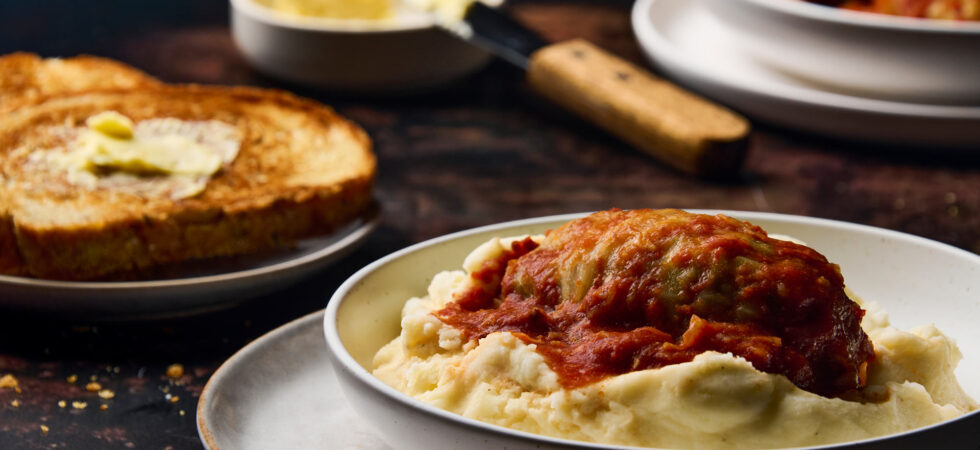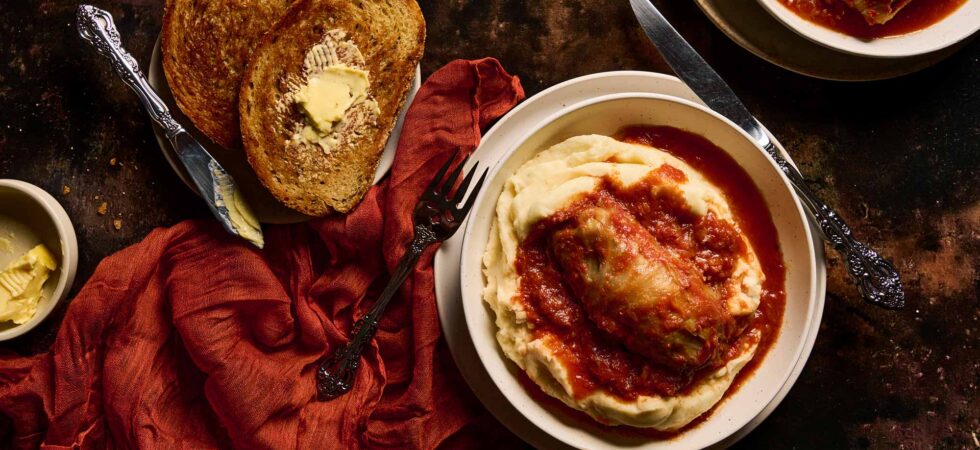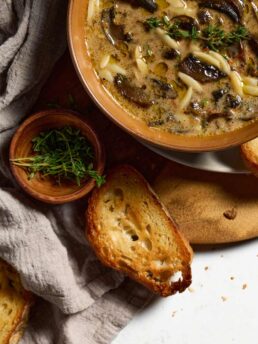Gołąbki: Polish Stuffed Cabbage

This is my dad’s recipe for gołąbki (Polish stuffed cabbage). It’s one of the first recipes I made with him as a child, and it was my go-to recipe for homesickness during college. I lost him to cancer several years ago, so whenever I want to be close to him, I make this meal. Sharing these recipes with the world means more to me than I can express. Even though you may never have met my father, knowing that his recipes—and the love behind them—are being passed on to your families is incredibly special to me. (Well, I didn’t expect to cry today, but here we are. 🤪) I hope you enjoy this stuffed cabbage recipe, aka a hug in a dish.
P.S. If you don’t have sides that you plan to eat with these, I suggest mashed potatoes and rye bread.

Get the Recipe: Gołąbki: Polish Stuffed Cabbage
Ingredients
Tomato Sauce Ingredients
- 3 cups V8 juice
- 1, 6 oz can of tomato paste
- 1 tablespoon Marmite
- 1/4 cup Bavarian style sauerkraut juice, drained from a 14.4oz (408g) can
- 2, 15 oz can tomato purée
Cabbage Roll Ingredients
- 1 medium-large head of green cabbage, (about 3.5lbs or 1.4kg)
- 2 lbs ground pork
- 2 lbs ground beef
- 1 cup long grain rice
- 1 medium yellow onion, finely diced, (1½ cups or 200g)
- 2 large eggs
- 1 teaspoon Diamond Crystal kosher salt
- 1 teaspoon ground black pepper
Assembly Ingredients
- prepared tomato sauce
- 22-28 trimmed cabbage leaves
- prepared filling
- any broken or leftover cooked cabbage leaves, chopped
- 1, 14.4 oz can of Bavarian style sauerkraut, drained of remaining liquid
Equipment
- 1 cutting board
- 1 chef knife
- 1 paring knife
- 1 colander
- 1 large stock pot
- 1 roasting pan
- 1 Small Sauce Pot
- 1 large mixing bowl
Instructions
- First, add all of the sauce ingredients to a medium pot and stir to combine. Bring the sauce to a simmer and cover. Cook until it’s time to prep your cabbage roll workstation.
- Next, place a tall stockpot on your stove, fill it with water about two-thirds of the way, and bring it to a gentle boil. Prep the cabbage by peeling off any loose outer leaves and cutting out as much of the core as possible. To remove the core, lay the cabbage on its side and use a paring knife to cut into the stalk at an angle. Rotate the cabbage as you work, making cuts that meet at a point in the center, like a cone. Once you've made a full rotation, you should be able to pull and scoop out the cut portion. If more of the core can be removed, continue cutting away at it.
- Submerge the cabbage as much as possible and then cover the pot for 10-15 minutes. Uncover and remove any translucent layers that are flexible enough to peel away without breaking. Set them aside, return the head of cabbage to the pot, and repeat. If any of the layers break apart that's okay, set them aside as well. Stack each complete leaf on a big plate until you have about 28 of them. This recipe makes between 22-28 rolls. Turn the stove down to a simmer. Then, return the loose cabbage leaves to the pot with whatever is left of the head, while you prep your cabbage roll filling (about 30 minutes).
- For the filling, add a small pot to your stove with the rice. Cover the rice with at least 2 inches of water. (You don't cook the rice with a lid, so it's important the rice stays submerged while cooking.) Bring to a boil for 10 minutes, so the rice is parboiled (half-cooked). While the rice is cooking, finely dice the onion and add that and the ground meats to a large mixing bowl. Strain and rinse the rice with water to wash the starches off and cool it down.
- Add the rice, eggs, salt and pepper to the bowl. When mixing the filling, fold everything together over and over until it starts to get uniform and then make a kind of claw with your hand to mix everything around the bowl. You can do this however you like but try not to over compress the mixture. You don't want to have dense cabbage rolls.
- Next, remove the cabbage leaves from the pot and place them back on your plate to cool. Once they are cool enough to touch, test each leaf by pushing down on the center vein. If you can flatten the whole leaf, it’s ready. If not, return it to the pot for another minute. When the leaves are flexible enough, trim them to a uniform thickness by running your knife horizontally down the center vein, where it starts to thicken, all the way to the end. Set the trimmed leaves aside.
- Now, set up your workstation for making the cabbage rolls. Roughly chop any leftover cabbage and broken leaves and place them in a bowl. Gather the drained can of sauerkraut, prepped leaves, sauce, and filling around a deep baking dish or roasting pan with a lid. I use a 16-inch x 12-inch x 3.5-inch (40.5 cm x 30.5 cm x 9 cm) oval roasting pan.
- Preheat your oven to 325°F (163°C). Start assembling by ladling enough sauce to cover the bottom of the baking dish. Sprinkle one-third of the canned sauerkraut and the chopped cabbage leaves on top of the sauce, then place the first layer of cabbage rolls on that.
- To make a cabbage roll, take an intact leaf and using its size as a guide, scoop out some meat mixture and roll it into an oblong log that’s about 1.5in (4cm) in diameter and between 3 and 5 inches (7.5-13cm) in length you don’t want the sides to taper. Place your oblong meatball centered at the trimmed end of the leaf and fold the leaf’s sides over it. Then roll the whole thing towards the other end of the leaf. Make sure the sides of the cabbage leaf are always tucked tightly under as you roll.
- Once you have a layer of rolls nestled tightly against each other without large gaps, ladle sauce over them until you can see liquid coming up between the rolls. Scatter another 1/3rd of the sauerkraut and chopped cabbage.
- Begin the second layer. Start in the center, placing the rolls in the grooves created from where the first layer’s rolls meet. Work your way out as you go. If you don’t make it all the way to the edges that’s okay. Ladle more sauce over the second layer and then top with the rest of the sauerkraut and cabbage.
- Cover the dish/pan, but make sure to place the lid so it’s slightly ajar. Bake for 3 hours. Serve with rye bread and your favorite style of potatoes.
Notes
- The tomato sauce is meant to be acidic, but if you need to mellow it out a bit, add some granulated sugar to the pot.
- Some gołąbki recipes use much less sauce or even leave it on the side to pour over after baking. I prefer a lot of sauce to keep everything moist while baking. In fact, I’ve been known to double the sauce recipe to have extra for bread dipping.
- If you don’t have a large enough pan, use multiple smaller dishes. I recommend using ones that allow for two layers, as layering always works better for me.
- Aim for about 1-1.5 inches (2.5-4 cm) of clearance between the top of the rolls and the top of the pan wall to prevent any leaking. If you’re worried about this, place a baking sheet with a Silpat underneath the dish to catch any spills.
- I’ll be honest: you can pull this out of the oven after about 90 minutes if you really can’t wait, but the extra time makes everything more tender. I’ll leave that decision up to you.
Nutrition

Frequently Asked Questions
Sure! Substitute cauliflower rice for the parboiled rice. Skip cooking the cauliflower before adding it to the meat mixture. You can use pre-frozen, packaged cauliflower rice or grate a fresh head of cauliflower with a box grater until you have the desired amount. The cauliflower will cook while the rolls are in the oven.
I would not recommend the use of a different type of cabbage. The waxy leaved of the green cabbage hold up to the boiling and baking. Savoy, Napa, and Bok Choy can’t hold up to that much heat for long.
When a leaf tears beyond repair, use it in the sauce or sauerkraut layers.
If the tear is small and you can still form a roll, continue as usual.
If the leaf is intact but has a slit, make what my family lovingly calls a “patch.” Take a piece from a previously torn leaf, place it over the slit, and then roll as if the leaf were whole.
Store stuffed cabbage in the refrigerator for up to 3 days. Since this meal makes a lot of servings, I break it up into separate containers. 1-2 cabbage rolls per person is a good benchmark.
From there, refrigerate or freeze the grouped rolls as needed. The freezer will keep the rolls good for up to 2 months.
Defrost the cabbage rolls by returning the frozen container to your refrigerator overnight. You can also defrost them in the microwave.
To reheat the rolls at the same time, slice into them and make 3-4 cuts on each roll. These cuts create more surface area, especially in the center of the roll, allowing heat to penetrate the meat faster and more evenly.
My personal favorite sides are mashed potatoes and buttered, toasted rye bread. Any starch works well with these.
That being said, stuffed cabbage doesn’t really need a side if you prefer not to make one. Just enjoy them as is.




Best cabbage rolls I’ve ever had. Sauce is delicious
Thank you for your comment. It made my day! 🙂